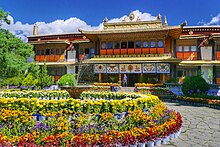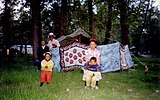Norbulingka
| Norbulingka | |
|---|---|
Tibetan: ནོར་བུ་གླིང་ག Wylie transliteration: Nor bu gling ga Chinese transcription(s) Traditional: 羅布林卡 Simplified: 罗布林卡 | |
 Norbulingka in 2017 | |
| Religion | |
| Affiliation | Tibetan Buddhism |
| Location | |
| Location | Lhasa, Tibet |
| Country | Tibet |
| Geographic coordinates | 29°39′14″N 91°05′30″E / 29.65389°N 91.09167°E |
| Architecture | |
| Founder | 7th Dalai Lama |
| Date established | 1755, completed 1783 |


Norbulingka (
Norbulingka Palace is situated in the west side of Lhasa, a short distance to the southwest of Potala Palace. Norbulingka covers an area of around 36 hectares (89 acres) and considered to be the largest man-made garden in Tibet.[3][4]
Norbulingka park is considered the premier park of all such horticultural parks in similar ethnic settings in Tibet. During the summer and autumn months, the parks in Tibet, including the Norbulingka, become hubs of entertainment with dancing, singing, music and festivities.[5][6] The park is where the annual Sho Dun or 'Yoghurt Festival' is held.
The Norbulingka palace has been mostly identified with the 13th and the 14th Dalai Lamas who commissioned most of the structures that still stand today. During the
Names
In
Geography and environment
The palace, with 374 rooms, is located 3 kilometres (1.9 mi) west of the
The park, situated at an elevation of 3,650 metres (11,980 ft) had flower gardens of
There is also a zoo at Norbulingka, originally created to house the animals which were given to the Dalai Lamas. Heinrich Harrer helped the 14th Dalai Lama build a small movie theater there in the 1950s.
History

Norbulingka Palace of the Dalai Lamas was built about 100 years after the Potala Palace was built on the
The earliest history of Norbulingka is traced originally to a spring at this location, which was used during the summer months by the 7th Dalai Lama to cure his health problems. The Qing dynasty permitted the Dalai Lama to build a palace at this location for his stay, as a resting pavilion. Since subsequent Dalai Lamas also used to stay here for their studies (before enthronement) and as a summer resort, Norbulingka came to be known as the Summer Palace of the Dalai Lama.[5]

The 8th Dalai Lama was responsible for many additions to the Norbulingka complex in the form of palaces and gardens. However, it is sometimes reported that 6th through to 12th Dalai Lamas died young and under mysterious circumstances, conjectured as having been poisoned. Most of the credit for the expansion of Norbulingka is given to the 13th and the 14th Dalai Lamas.[7]
It was from the Norbulingka palace that the Dalai Lama escaped to India on 17 March 1959, under the strong belief that he would be captured by the Chinese. On this day, the Dalai Lama dressed like an ordinary Tibetan, and, carrying a rifle across his shoulder, left the Norbulinga palace and Tibet to seek asylum in India. As there was a dust storm blowing at that time, he was not recognized. According to Reuters, “The Dalai Lama and his officials, who had also escaped from the palace, rode out of the city on horses to join his family for the trek to India”. The Chinese discovered this "great escape" only two days later. The party journeyed through the Himalayas for two weeks, and finally crossed the Indian border where they received political asylum.[11] Norbulingka was later surrounded by protesters and subject to an attack by the Chinese.[11][12][13]
The summer residence of the Dalai Lama, located in the Norbulingka Park, is now a tourist attraction. The palace has a large collection of
Layout
Built in the 18th century, the Norbulingka Palace and the garden within its precincts have undergone several additions over the years. The vast complex covers a garden area of 3.6 km2 including 3.4 km2 of lush green pasture land covered with forests. It is said to be the “highest garden” anywhere in the world and has earned the epithet “Plateau Oxygen Bar.”[5][6]
The Norbulingka is the "world's highest, largest and best-preserved ancient artificial horticultural garden"., which also blends gardening with architecture and sculpture arts from several Tibetan ethnic groups; 30,000 cultural relics of ancient Tibetan history are preserved here.
The earliest building is the Kelsang Palace built by the
The Norbulingka ’s most dramatic area was the Lake Palace, built in the southwest area. In the centre of the lake, three islands were connected to the land by short bridges. A palace was built on each island. A horse stable and a row of four houses contained the gifts received by the Dalai Lamas from the Chinese emperors and other foreign dignitaries.[15]
Construction of the 'New Palace' was begun in 1954 by the present Dalai Lama, and completed in 1956. It is a double-story structure with a Tibetan flat roof. It has an elaborate layout with a maze of rooms and halls. This modern complex contains chapels, gardens, fountains and pools. It is a modern Tibetan-style building embellished with ornamentation and facilities. In the first floor of this building, there are 301 paintings (frescoes) on Tibetan history, dated to the time when Dalai Lama and the Panchen Lama met Chairman Mao Zedong.[6][17] As of 1986, the palace had an antique Russian radio, and a Philips console still containing old 78 rpm records.[1]

The entire Norbulingka complex was delimited by two sets of walls. The area encompassed by the inner wall, painted yellow, was exclusively for the use of the Dalai Lama and his attendants. Officials and the Dalai Lama's royal family lived in the area between the inner yellow wall and the outer wall. A dress code was followed for visitors to enter the palace; those wearing Tibetan dress were allowed; guards posted at the gates controlled the entry, and ensured that no western hat-wearing people (which was made popular in Tibet during Lhamdo Dhondups time) were allowed inside. Wearing shoes inside the park was banned. Guards at the gate offered a formal arms salute to the nobles and high-ranking officials. Even the officials at the lower category also received a salute. The gates outside the yellow wall were heavily protected. Only the Dalai Lama and his guardians could pass through these gates. Tibetan mastiff dogs kept in niches of the compound walls, and tied with long yak hair leashes, were the guard dogs that patrolled the perimeter of the Norbulingka.[15]
On the east gate to the Norbulingka there are two Snow Lion statues covered in khatas (thin white scarves offered as a mark of respect), the Snow Lion on the left is accompanied by a lion cub. The mythical Snow Lion is the symbol of Tibet; according to legend they jump from one snow peak to another. Most of the buildings are closed now; have become storehouses or used as offices for those who take care of the maintenance works. Some additional buildings seen now are souvenir kiosks catering to the visitors.[7]
Restoration and preservation

During the Cultural Revolution, the Norbulingka complex suffered extensive damage.
Norbulingka was declared a "National Important Cultural Relic Unit”, in 1988 by the State council. On 14 December 2001,
Festivals

During the reign of the Dalai Lamas (from the 7th Dalai Lama onwards), their annual shifting of residence from the Potala Palace to Norbulingka Palace was also an elaborate festive event. The Dalai Lama used to be escorted in a glittering procession to spend 6 months of the summer season in the Norbulingka Palace.[7]
Gallery
-
Norbulingka, 1993
-
Tibetan family at Sho Dun Festival, Norbulingka, 1993
-
Partying at Sho Dun Festival, Norbulingka, 1993
-
Norbulingka. Sho Dun, the 'Yoghurt Festival', 1993.
-
Bathroom of the 14th Dalai Lama at Norbulingka
References
Citations
- ^ a b c Tibet (1986), p.71
- ^ a b "World Heritage Committee Inscribes 31 New Sites on the World Heritage List". UNESCO. 2001-12-13. Retrieved 2010-05-31.
- ^ "Norbulingka Palace". Tibet Tours. Retrieved 2010-05-18.
- ^ "Norbulingka". Cultural China. Archived from the original on 2011-07-19. Retrieved 2010-05-23.
- ^ ISBN 7-5085-0374-0. Retrieved 2010-05-29.
- ^ a b c d e "Norbulingka (the Summer Palace)". Travel China Guide. Retrieved 2010-05-29.
- ^ ISBN 1-84162-164-1. Retrieved 2010-05-29.
Norbulingka, Lhasa.
- ISBN 978-1-4481-1429-0.
- ISBN 978-0-7538-1990-6.
- ISBN 81-7436-085-9.
- ^ a b "Witness: Reporting on the Dalai Lama's escape to India". Reuters News Agency. 2009-02-27. Retrieved 2010-05-03.
- ^ ISBN 81-208-1370-7. Retrieved 2010-05-29.
- ISBN 1-888375-35-3. Retrieved 2010-05-29.
- ^ Seth, pp.140–141
- ^ ISBN 0-313-32207-4. Retrieved 2010-05-29.
Norbulingka, Lhasa.
- ISBN 0-7102-1370-0, pp. 62–63.
- ^ a b c Chinese,p. 93
- ^ "China through a Lens". China.org.cn. Retrieved 2010-05-23. [dead link]
- ISBN 1-900949-33-4. Retrieved 2010-05-29.
- ISBN 1-885211-76-7. Retrieved 2010-05-29.
Sources
- Bass, Catriona. 1990. Inside the Treasure House: A Time in Tibet. Victor Gollancz, London. Paperback reprint: Rupa & Co., India, 1993
- Dowman, Keith. 1988. The Power-places of Central Tibet: The Pilgrim's Guide. Routledge & Kegan Paul, London and New York. ISBN 0-7102-1370-0
- Palin, Michael (2009). Himalaya. London: Penguin. ISBN 978-0-7538-1990-6.
- Seth, Vikram (1990). From Heaven Lake: Travels through Sinkiang and Tibet. Penguin. ISBN 0-14-013919-2.
- Tibet: A Fascinating Look at the Roof of the World, Its People and Culture. Passport Books. 1988. p. 71.









